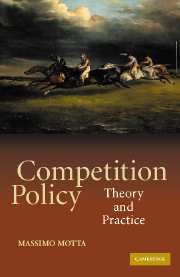Book contents
- Frontmatter
- Dedication
- Contents
- List of Figures
- List of Tables
- Preface
- Acknowledgements
- List of Abbreviations
- 1 Competition Policy: History, Objectives, and the Law
- 2 Market Power and Welfare: Introduction
- 3 Market Definition and the Assessment of Market Power
- 4 Collusion and Horizontal Agreements
- 5 Horizontal Mergers
- 6 Vertical Restraints and Vertical Mergers
- 7 Predation, Monopolisation, and Other Abusive Practices
- 8 A Toolkit: Game Theory and Imperfect Competition Models
- Bibliography
- References to Cases and Legislation
- Index
8 - A Toolkit: Game Theory and Imperfect Competition Models
Published online by Cambridge University Press: 05 August 2015
- Frontmatter
- Dedication
- Contents
- List of Figures
- List of Tables
- Preface
- Acknowledgements
- List of Abbreviations
- 1 Competition Policy: History, Objectives, and the Law
- 2 Market Power and Welfare: Introduction
- 3 Market Definition and the Assessment of Market Power
- 4 Collusion and Horizontal Agreements
- 5 Horizontal Mergers
- 6 Vertical Restraints and Vertical Mergers
- 7 Predation, Monopolisation, and Other Abusive Practices
- 8 A Toolkit: Game Theory and Imperfect Competition Models
- Bibliography
- References to Cases and Legislation
- Index
Summary
INTRODUCTION
This chapter introduces the reader to imperfect competition models that are used in the technical sections of the book (specifically, the intermediate technical sections, labelled*; the advanced technical sections, labelled**, will likely need a stronger background than the one which is offered in this chapter).
Of course, this is no replacement for more proper training in basic industrial organisation models, but the chapter should help some students who have already some background in economics and in simple mathematical analysis (I use little more than derivatives of real functions in the book and in this chapter), or those who want to refresh a knowledge acquired some time ago, to follow the formal arguments made in the book.
The choice of the topics analysed here is functional, with the objective of helping the reader follow the book. The chapter starts with a short treatment of monopoly (Section 8.2), then introduces the reader to elementary game theory (Section 8.2.2.3), which is indispensable for understanding modern oligopoly theory, which for convenience I divide into static models (Section 8.3) and dynamic models (Section 8.4).
MONOPOLY
This section offers an introductory treatment of monopoly pricing. First the case of a single-product monopoly and then that of a multi-product monopoly are analysed.
8.2.1 Single-Product Monopoly
The easiest possible model of imperfect competition is one where there is a monopolist that sells only one good. I will first solve the monopolist's problem with general cost and demand functions, and then offer some specific examples.
Denote demand for this good as q = D(p), where p is the price and q output, and assume that demand is negatively sloped: ∂ D/∂p < 0.
- Type
- Chapter
- Information
- Competition PolicyTheory and Practice, pp. 533 - 580Publisher: Cambridge University PressPrint publication year: 2004



